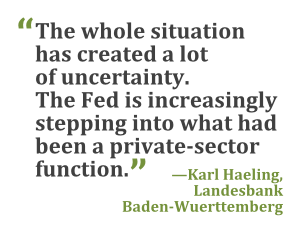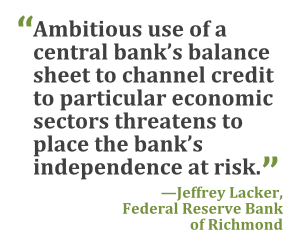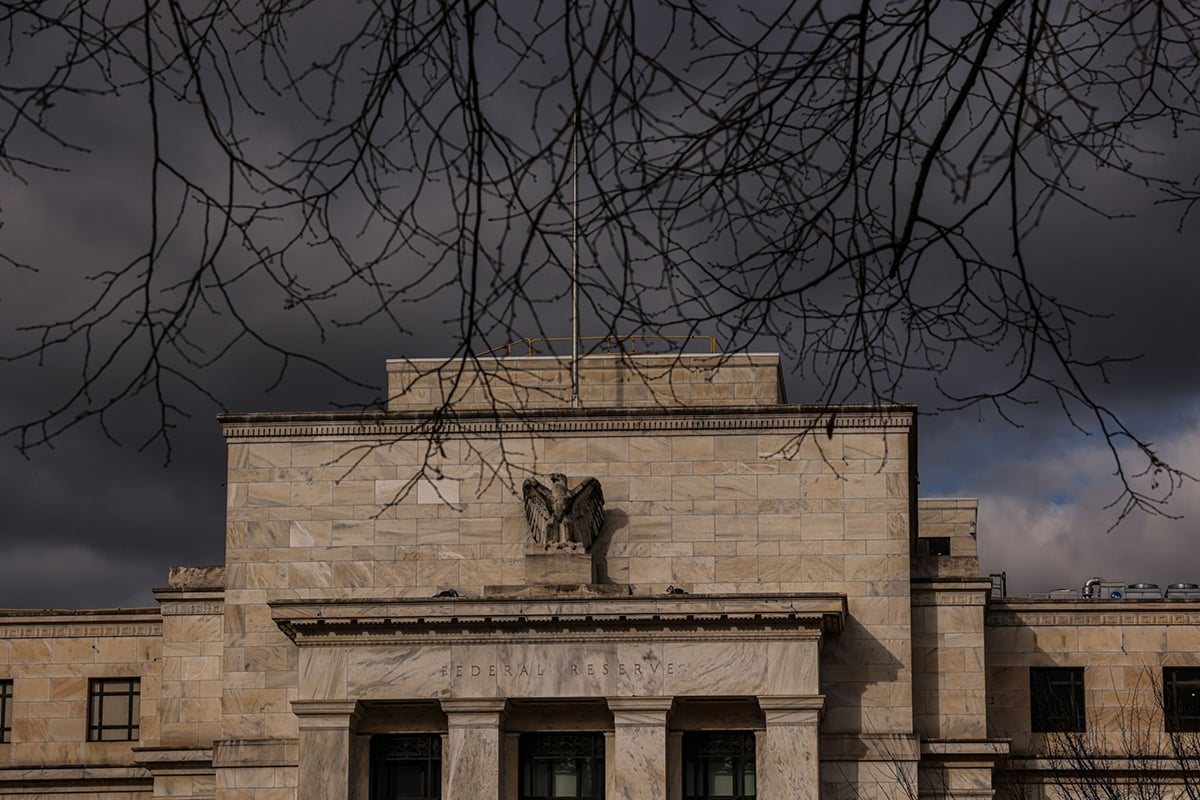Federal Reserve officials, concerned that selling bonds fromtheir $4.3 trillion portfolio could crush the U.S. recovery, arepreparing to keep their balance sheet close to record levels foryears.
|Central bankers are stepping back from a three-year-old strategyfor an exit from the unprecedented easing they deployed to battlethe worst recession since the Great Depression. Minutes of theirlast meeting in April made no mention of asset sales.
|Officials worry that such sales would spark an abrupt increasein long-term interest rates, making it more expensive for consumersto buy goods on credit and companies to invest, according to JamesBullard, president of the Federal Reserve Bank of St. Louis.
|That “is a widespread view in parts of the Fed, I think, and infinancial markets,” Bullard said in an interview last week. Whilehe disagrees with that perspective, it “won the day.”
| The Fed is testing new tools that would allow it to keep alarge balance sheet even after it raises short-term interest rates,a step policy makers anticipate taking next year. They would usethese tools to drain excess reserves temporarily from the bankingsystem.
The Fed is testing new tools that would allow it to keep alarge balance sheet even after it raises short-term interest rates,a step policy makers anticipate taking next year. They would usethese tools to drain excess reserves temporarily from the bankingsystem.
“It is pretty clear they are anticipating operating in asituation with a lot of reserves and a high balance sheet for along time,” said former Fed governor Laurence Meyer, a co-founderof Macroeconomic Advisers LLC, a St. Louis-based forecastingfirm.
|The strategy, which would make the Fed one of the biggestplayers in money markets, carries risks. In a time of crisis,investors could flock to safe short-term instruments created by theFed, potentially starving the rest of the financial system offunding.
|“The whole situation has created a lot of uncertainty,” saidKarl Haeling, head of strategic debt distribution at LandesbankBaden-Wuerttemberg in New York. “The Fed is increasingly steppinginto what had been a private-sector function.”
|The Fed's asset purchases have expanded its balance sheet to 25percent of gross domestic product (GDP) from 6 percent at the startof 2007. Central banks from Japan to the U.K. also will have todevelop strategies for operating with large portfolios. Forexample, the Bank of England's is 24 percent of GDP, up from about6 percent in 2007.
|Fed officials led by Chair Janet Yellen, who meet June 17-18,anticipate raising their benchmark federal funds rate next year forthe first time since 2006. They will release new forecasts for theeconomy and the outlook for the benchmark after next week'smeeting.
|Strategic Shift
|Maintaining a large balance sheet in a tightening period wouldmark a strategic shift for the Fed and reverse much of centralbanking doctrine from the 1990s and early 2000s, which favoredminimal interference in the economy.
|Under then-Chairman Alan Greenspan, the Fed targeted the fedfunds rate, the cost of overnight loans among banks, and left mostother interest rates to markets. Officials avoided subsidizingcredit to specific industries, such as housing, to avoid opening aPandora's Box of requests to aid other sectors.
|That changed after the collapse of Lehman Brothers Holdings Inc.in 2008, when the central bank cut the fed funds rate almost tozero. Seeking more ways to stimulate growth, the Fed then began aneffort to influence longer-term rates on home loans and other debtwith purchases of longer-term Treasuries, mortgage-backedsecurities, and housing-agency debt.
||“Ambitious use of a central bank's balance sheet to channelcredit to particular economic sectors or entities threatens toentangle the central bank in distributional politics and place thebank's independence at risk,” Richmond Fed president JeffreyLacker, one of the biggest internal critics of the policy, said ina May 13 speech.
|The Fed's purchases created $2.54 trillion of bank reserves inexcess of what lenders are required to hold against deposits. Thecentral bank needs to tie up or extinguish that money to raise theshort-term interest rate above its current range of zero to 0.25percent.
| Toward that end, Fed officials in June 2011 adopted anexit strategy that aimed to return the balance sheet to itspre-crisis size. The strategy called first for allowing the balancesheet to shrink gradually as assets matured. The Fed later wouldraise the short-term rate and then slowly start to sell assets,focusing on ridding the portfolio of housing debt.
Toward that end, Fed officials in June 2011 adopted anexit strategy that aimed to return the balance sheet to itspre-crisis size. The strategy called first for allowing the balancesheet to shrink gradually as assets matured. The Fed later wouldraise the short-term rate and then slowly start to sell assets,focusing on ridding the portfolio of housing debt.
'Smallest Levels'
|The size of the balance sheet and quantity of bank reserves wereto be “reduced to the smallest levels that would be consistent withthe efficient implementation of monetary policy,” according tominutes of the meeting.
|The strategy started to change last June, when then-Chairman BenS. Bernanke said most officials didn't favor selling the Fed'sportfolio of housing debt, now valued at $1.6 trillion. Instead,the portfolio would be allowed to shrink gradually as the bondsmatured.
|William C. Dudley, president of the New York Fed and vicechairman of the Federal Open Market Committee, went further in aMay 20 speech, saying the central bank should continue to reinvestmaturing debt even after it raises interest rates.
|Not all Fed officials agree. “Allowing the balance sheet todecline due to 'passive runoff'—which stops reinvesting thematuring securities—prior to the first rate hike is appropriate,”Kansas City Fed President Esther George said in a June 3 speech inColorado.
|Expectations that the Fed will refrain from selling assets havehelped drive yields on 10-year Treasury notes down to 2.64 percentlate yesterday, from 3.03 percent at the end of last year. ATreasuries selloff pushed yields on those notes to the highestlevel in four weeks before the U.S. sells $21 billion of thesecurities today.
|The Fed's portfolio “matures, it pays down, but it doesn't getsold,” said Deborah Cunningham, chief investment officer for globalmoney markets at Federated Investors Inc. in Pittsburgh, whichmanages $366 billion.
||The reason, according to Cunningham: Officials want to avoid arepeat of the “violent reaction” when Bernanke said last June thatthe Fed would begin to taper its asset purchases soon. Ten-yearTreasury yields jumped 0.81 percentage points in less than threemonths after those comments, and 30-year mortgage rates increasedby 0.66 point.
|Housing markets sputtered. After boosting the economy for 12straight quarters, residential investment subtracted 0.26percentage point from growth in the fourth quarter of 2013 and 0.18point in the first period of this year, when the economy as a wholecontracted.
|“The reaction would be 10 times worse” if the Fed decided tosell securities, Cunningham said. “I don't think they want to riskthat.”
|Monthly Pace
|The Fed has since started reducing the monthly pace of bondpurchases, now $45 billion, and is on course to end them late thisyear. That still will leave the Fed with trillions of excess cashto soak up.
|One way to tie up that money would be to raise the interest ratethe Fed pays on excess reserves, currently 0.25 percent. Yetbecause banks aren't the only participants in the federal fundsmarket, the Fed also intends to absorb cash held by federalhome-loan banks and mutual funds.
|It would do that with reverse repurchase agreements, givingcounterparties securities in exchange for overnight loans of cash.The transactions later would be reversed.
|For the first time, investment management companies such asBlackRock Advisors LLC and the Vanguard Group Inc. would be able tolend cash directly to the Fed.
|Lou Crandall, chief economist at Wrightson ICAP LLC, who hasbeen watching money markets and Fed policy for three decades,compared the importance of the shift in strategy with the Fed'sdecision to establish a monopoly on bank-note issuance after itsfounding in 1913.
|One reason the Fed may stick with the strategy for a long time:It would provide safe assets that banks need to fulfill stricterrequirements for capital and liquidity imposed by regulators sincethe financial crisis.
|“One of the fundamental tenets of financial reform is thateverybody is required to hold a lot of liquidity and nobody isallowed to provide it,” said Crandall, who is based in Jersey City,New Jersey. “The Fed has bridged the gap.”
|A large balance sheet with U.S. Treasury and mortgage-backedsecurities has other benefits for the Fed.
|It provides “continuing options for impacting long-term interestrates,” Eric Rosengren, president of the Boston Fed, said at aconference this week in Guatemala City.
|Meyer said the FOMC now doesn't appear worried about having abig balance sheet, and many officials “prefer to operate at ahigher level of reserves.”
|“There is a preference emerging to say, 'This works,'” Meyersaid. “The question is: Do they ever want to get back tonormal?”
|Copyright 2018 Bloomberg. All rightsreserved. This material may not be published, broadcast, rewritten,or redistributed.
Complete your profile to continue reading and get FREE access to Treasury & Risk, part of your ALM digital membership.
Your access to unlimited Treasury & Risk content isn’t changing.
Once you are an ALM digital member, you’ll receive:
- Critical Treasury & Risk information including in-depth analysis of treasury and finance best practices, case studies with corporate innovators, informative newsletters, educational webcasts and videos, and resources from industry leaders.
- Exclusive discounts on ALM and Treasury & Risk events.
- Access to other award-winning ALM websites including PropertyCasualty360.com and Law.com.
*May exclude premium content
Already have an account? Sign In
© 2024 ALM Global, LLC, All Rights Reserved. Request academic re-use from www.copyright.com. All other uses, submit a request to [email protected]. For more information visit Asset & Logo Licensing.







